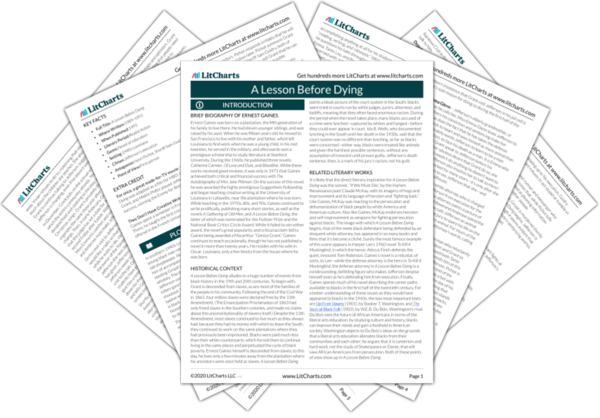Summary
Analysis
In the weeks before Grant begins visiting Jefferson in jail, two things happen at school: the superintendent makes an annual visit, and the school gets a load of kindling for the winter. To prepare for the superintendent, whose visit Farrell Jarreau has heard Pichot discussing, Grant preps his students, spanning grades one to six, in civics and the Pledge of Allegiance and tells them to wear their best clothes. He has one of the older boys keep watch so that when the superintendent’s car arrives, he’ll know a few minutes in advance.
While Grant refused to hide his intelligence in order to make a good impression on Pichot in the previous chapter, here he does try to ensure his school makes a good impression on the superintendent, because he needs the superintendent’s support in order to improve the school. Farrell Jarreau proves himself to be a valuable source of information: the fact that he can extract bits of information from Pichot without Pichot telling him attests to Farrell’s unrecognized intelligence.
Themes
When the superintendent arrives, Grant greets him as Dr. Joseph, and notes that he is an old, fat, red-faced man who visits the district’s Black schools half as often as he visits white schools. As the superintendent enters the classroom, the students, aged six to thirteen, rise, as Grant has instructed them to do in advance, and Grant introduces them to Dr. Joseph Morgan. Morgan quizzes the students, including a young girl named Gloria Herbert. He asks Gloria to show him her hands and name a Bible verse; her hands are clean and she successfully recites the verse. Morgan tells her that she’s a “bright little girl.”
We note immediately that Dr. Joseph is out of touch with the people he’s visiting: he’s white, well-fed (unlike the poor students who have to search for their own food), and presumably wealthy. Morgan quizzes the young student and calls her a bright girl: while this might suggest that Morgan isn’t as much of a racist as the other white people we’ve seen in the novel, this kind of paternalistic behavior was actually quite common among racists at the time (and perhaps still is). Morgan seems to treat Black people like animals: charming, “bright,: but still subhuman.
Themes
The next student Morgan calls on is a boy, Louis Washington, Jr., who Grant wishes had stayed home, because he is ill-behaved and a bad student. Morgan asks Louis to recite the Pledge of Allegiance, and Louis gives a garbled rendition of the Pledge, leaving out many of the words. Morgan only grunts and moves on. He proceeds in this way, talking to bright-looking students and then foolish-looking ones. He inspects the students’ teeth, a practice that was used, Grant remembers, by slave masters at slave auctions. After he finishes quizzing the class, Morgan tells everyone that beans and fish are good for their health, and encourages them to exercise. He compliments Grant, who he calls “Higgins,” on his excellent “crop of students.”
It’s important that Morgan offers no constructive criticism of Washington’s Pledge of Allegiance: he only recognizes that Washington is a poor student, and moves on. His attitude toward the students is like that of a collector examining his specimens. (He calls the students a “crop,” as if they are a collection of plants, not people.) This is largely what reminds Grant of slave masters buying slaves at the auctions. Further, Morgan’s comment about fish and beans being good for the students’ health suggests that he cares more about their bodies—as workers, for white people—than about their minds.
Themes
While the student teacher, Irene, leads the class, Grant speaks with Morgan outside. He tells Morgan that he needs new books and more chalk for the blackboards; Morgan only replies that all schools, both white and Black, are in the same shape. When Grant protests that his books are handed down from white schools, Morgan accuses him of questioning his honesty. Morgan climbs into his car and tells Grant that he has to tell his students to buy toothbrushes. When Grant tells him that the students have no money for toothbrushes, Morgan says that the “lazy” children should be put to work picking pecans from the surrounding trees. He drives away without waving.
Morgan is clearly lying when he says that the school district treats the Black and white schools equally. This alludes to Plessy V. Ferguson, the 1896 Supreme Court decision that established the doctrine of “separate but equal.” Black people were allowed to attend all-Black schools, under the bogus provision that the schools be comparable to white schools. In reality, Black schools were underfunded and given less attention than their white counterparts: this is obvious simply in the fact that the Black students get outdated hand-me-down textbooks from white students. It’s alarming, then, to hear that Morgan blames the children for their own poverty, calling them “lazy.” Grant wanted to try to impress Morgan in order to get more support for his school; but just as the jury that convicted Jefferson saw him as immediately guilty, Morgan was never going to be impressed because he’s racist.
Themes
Get the entire A Lesson Before Dying LitChart as a printable PDF.













